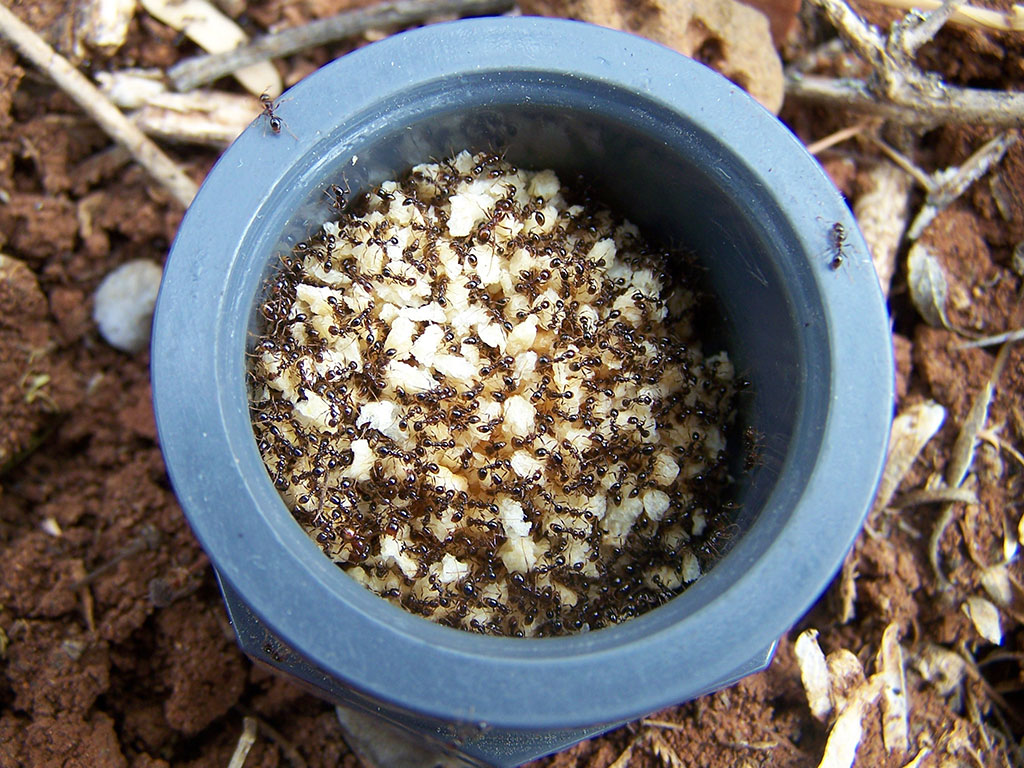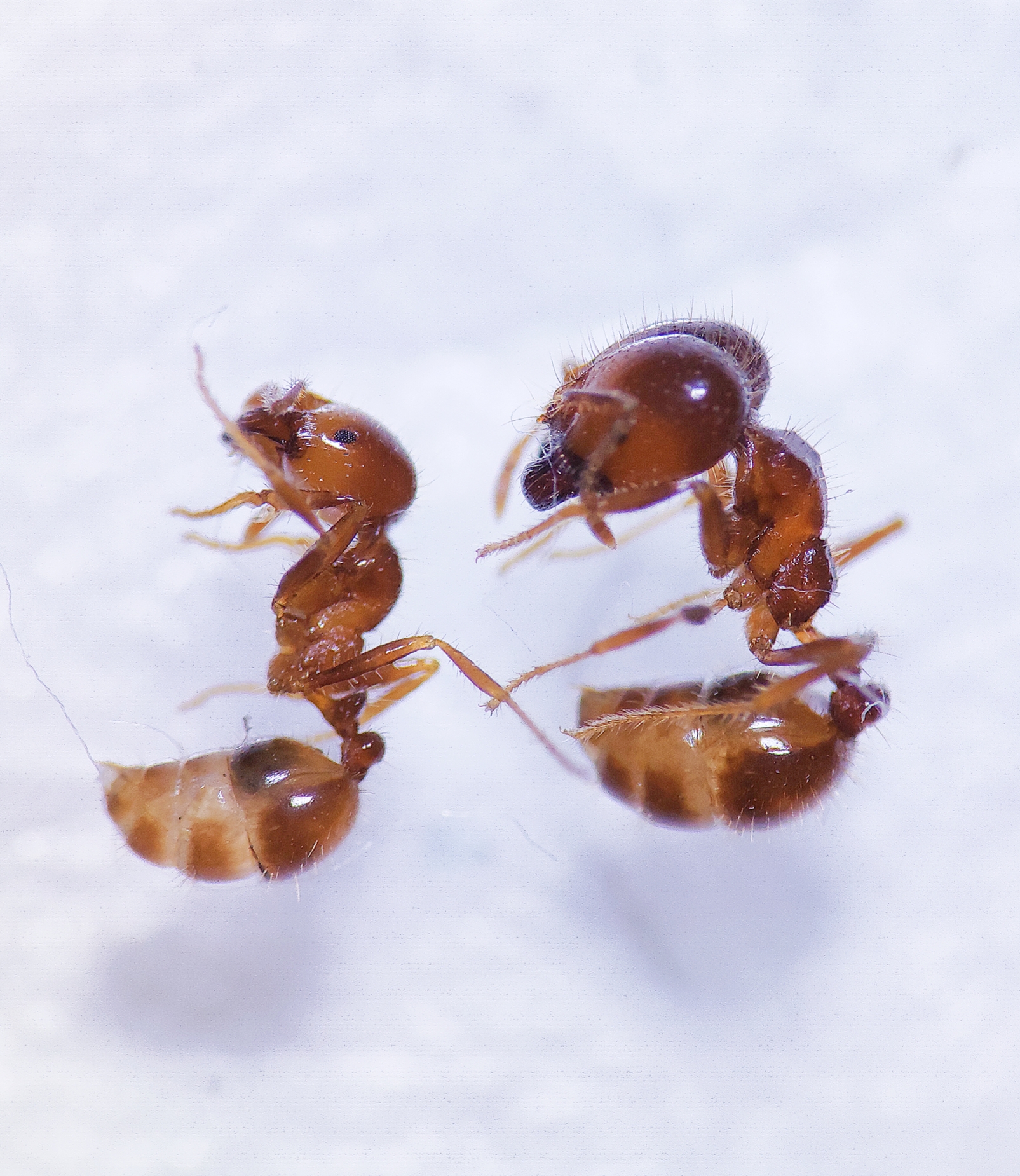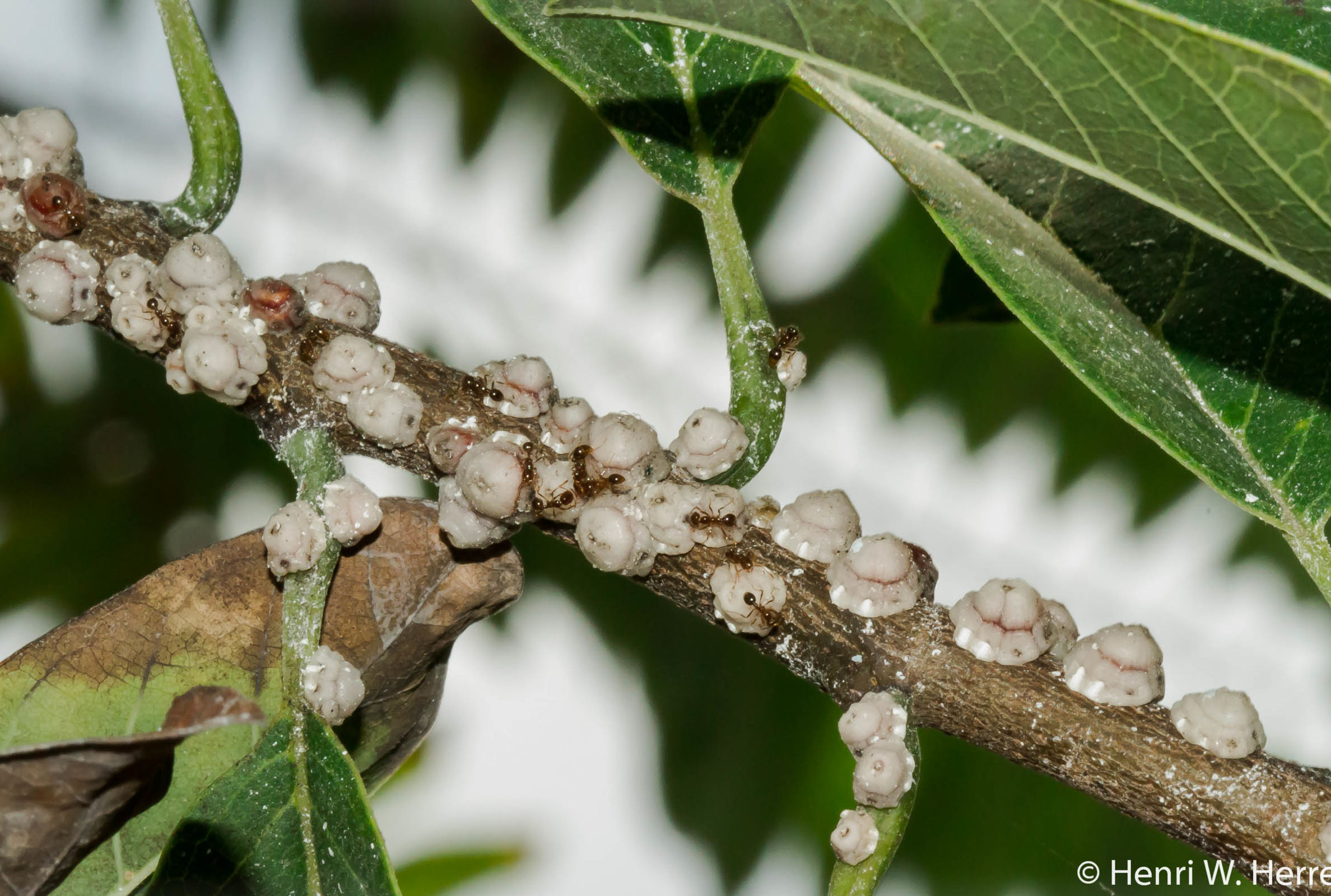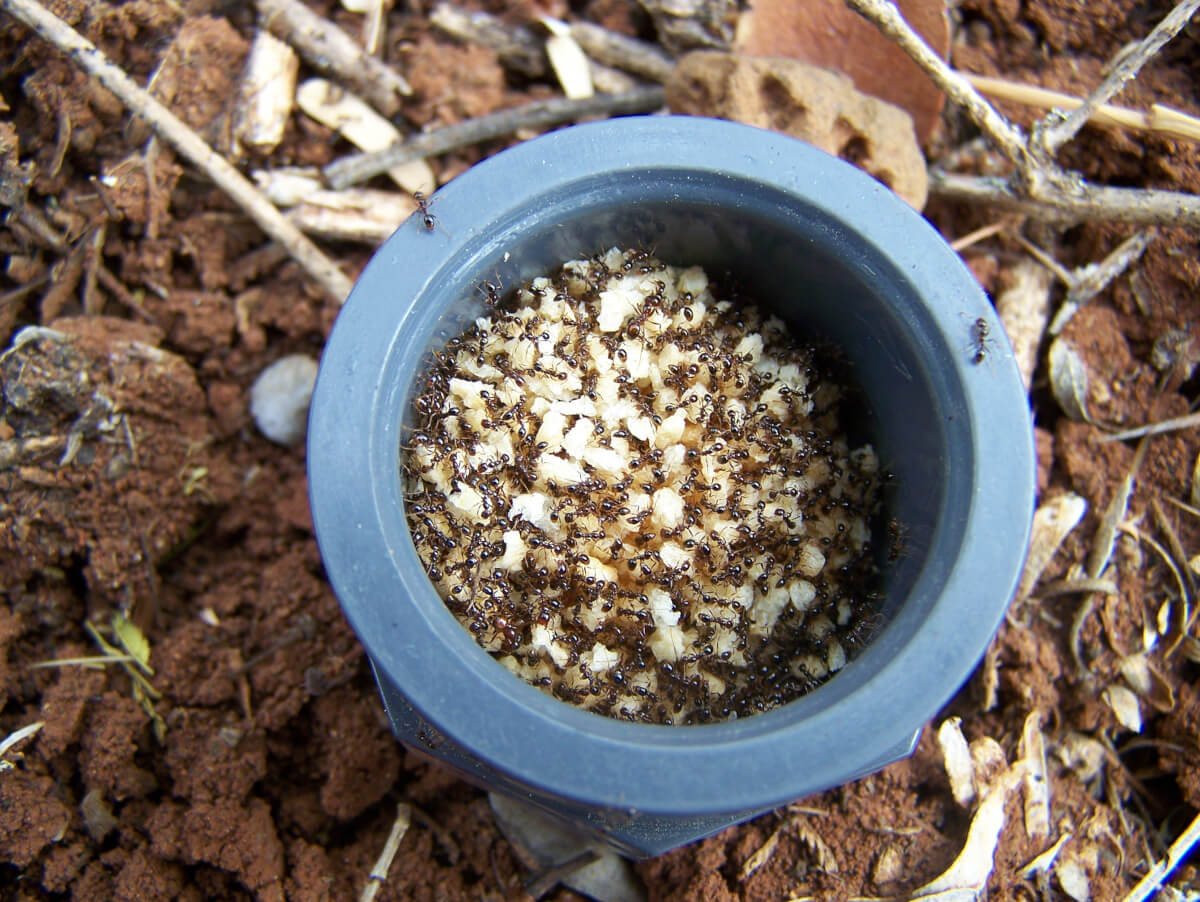Galapagos Species Database
The Galapagos Species Database shares the information about the species from our Natural History Collections.
Solenopsis geminata
Hormiga de fuego, hormiga negra, hormiga del fuego tropical, hormiga de fuego tropical, Tropical fire ant







Tropical fire ants are 3-5mm long and orange to brown in color with brown, square heads. Workers are polymorphic, which means they have multiple different body sizes and forms. Tropical fire ants live in large, aggressive colonies and are known for their painful sting.
Domain
Eukaryota
Kingdom
Animalia
Phylum
Arthropoda
Class
Insecta
Order
Hymenoptera
Suborder
Apocrita
Superfamily
Vespoidea
Family
Formicidae
Section
Solenopsidini
Genus
Solenopsis
Species
geminata
Taxon category: Accepted
Taxon origin: Introduced - established
Preference for an altitude zone in Galapagos: Coastal zone - high altitude dry zone
Habitat preferences: Only found in hot or arid regions, and is intolerant of cold. Prefers disturbed habitats, such as forest edges and agricultural areas. Usually nests in open areas in dry to moist soil. This species prefers low to mid-elevations below 500 m, but has been reported to occur at elevations of 1000 m.
Feeding preferences: Solenopsis geminata is a predator of invertebrates, but is also known to eat seeds. The morphologically distinctive larger worker ants are specialized in collecting and feeding on seeds of many species of plants, including weeds and crops. A portion of the diet of this species consists of the sugary substances excreted by Homoptera (honeydew).
Trophic role: Omnivorous
Persistence mechanisms: Attributes that make Solenopsis geminata a successful invader include its adaptability to a wide range of habitats, polyphagous feeding habits, high interspecific aggression, and lack of intraspecific aggression which at times can lead to unicoloniality. Colonies are commonly polygynous (have multiple queens), increasing the likelihood that small numbers of ants that are split off from the colony, or are transported by man, are able to found a new colony.
Reproduction mode: Both sexual and asexual
Reproductive biology: The winged reproductive male and female leave the nests late in the day on mating flights. This usually follows rains during warmer periods of the year. There are two forms of queen ants and they have different mating strategies. After mating, the female reproductive ants or queens drop their wings and dig a burrow and lay their eggs. Development from egg to adult can take from 3 to 4 weeks and up to 2 months. Colony maturity occurs in 1 to 2 years. The colonies of Solenopsis geminata can either be monogyne (contain a single queen ant), or polygyne (contain many reproductively-active queen ants). In Galápagos they appear to be polygynous. The nests are formed as craters or mounds. The density of colonies in areas varies greatly and can range from 20 mounds per hectare to 160 mounds per hectare in native habitats. In some areas the polygyne forms of the ant can reach up to 2000 mounds per hectare The colonies frequently migrate to new locations, migrating over 300 m from the original nest locations. Colonies can be large and extend deep into the ground.
Distribution origin: Tropical and temperate regions of America
Dispersal propagule: Can be spread by human activities (in soil or other material suitable for nests), or naturally by nuptial flights or on vegetation rafts. Solenopsis geminata tends to spread through flights, especially in hot weather. The results of eradication programs implemented in Galapagos and other Pacific islands suggest that Solenopsis geminata can island hop from islands approximately 1 km away. To our knowledge, there is only one proven case of Solenopsis geminata flying between islands (Ben Hoffman, personal communication).
Natural enemies: Pseudacteon bifidus, Pseudacteon crawfordi (decapitating flies of the family Phoridae). These flies insert their eggs into worker ants and the larva migrates to the head capsule where it develops, decapitates the ant and then uses that ant head as a pupal case. Their main impact, however, is not direct mortality of the ants, but rather an indirect effect through disrupting foraging behavior.
Mode of introduction: Accidental
Introduction Pathway: Contaminant
Subpathway: On habitat material (soil, vegetation)
Introduced status: Naturalized
Invasive status: Invasive
Invasion risk score: High risk
Impact in Galapagos: This fire ant is having a serious socioeconomic impact in the Galápagos and is also taking its toll on native biodiversity. It preys on invertebrates and small vertebrates, while its mutualistic relationship with scale insects and aphids can seriously debilitate plants. These ants have disrupted tortoise and bird breeding efforts in the Galapagos. Tropical fire ants also affect agricultural activities (painful stings affect farm work), domestic animals, and can produce allergic reactions in humans.
Impact elsewhere: It has the potential to invade native communities and affect both animals and plants. There is evidence of Solenopsis geminata reducing native butterfly populations in Guam and affecting seabird nesting on islands in the Pacific. Solenopsis geminata feeds on honey dew produced by Homoptera especially scale insects. This helps increase the populations of these plant pests and the incidence of disease associated with these Homoptera. Ants are also known to physically damage crop plants. Solenopsis geminata affects humans and pets. Many ants can attack a person when a colony is disturbed and the victim can suffer multiple stings because each ant can sting several times. The sting produces an immediate, intense pain followed by swelling and redness. Cases of anaphylactic shock have been reported.
Control History in Galapagos: Eradication and management of Solenopsis geminata has been underway since the 2000's and is based on the methodology used for Wasmannia auropunctata using poison baits containing Hydramethylnon followed by intensive monitoring with sticks painted with peanut butter. Eradication has been attempted on small islets including Las Marielas (they have two penguin colonies) and on Champion Island (home of the Floreana Mocking bird), but has not been successful. All of these islets are close to larger islands that are invaded by Solenopsis geminata and it is likely that recolonization has ocurred. These programs were evaluated in 2012 and a strategic plan for invasive ant management produced.
Control methods elsewhere: In some programs in other parts of the world, the application of Amdro® (Hydramethylnon) has resulted in a reduction in population numbers, but not in the total elimination of Solenopsis geminata. Plentovich and colleagues were unable to eradicate Solenopsis geminata from a 4.8 ha island near Hawaii after two applications (Plentovich et al., 2011) or Spit Island (6 ha) in the Pacific (Plentovich et al, 2010). They attributed failure to the biology of the ant (number of queens, connectivity between nests and distribution of resources), ant densities (at low densities they are unable to find the bait), the topography, and lack of vegetation on the islets (bait decomposed quickly because it was exposed to the elements). It is also possible that there has been re-colonization from nearby islets. In northern Australia, Hoffmann and O'Connor (2004) failed to eradicate Solenopsis geminata from an area of approximately 3 acres with 10 applications of Amdro®. They only managed to eradicate it after switching to nest treatments with Diazinon.
Known Pest elsewhere: Widely dispersed in tropic and temperate regions.
Prevention options: Inspect all fruits, vegetables, and food for ants. Prohibit movement of soil between islands or regions.
Year of first record: 1891
Map of specimen collection localities or observation records for this species in our collections database.
Distribution: Albany, Bainbridge #1, Baltra, Bayas, Champion, Cuevas, Eden, Enderby, Fernandina, Floreana, Gardner (next to Floreana), Isabela, Mariela Grande, Mao, Mariela Mediana, Plaza Sur, Santa Fé, Santiago, San Cristóbal, Santa Cruz and Seymour Norte.
- Peck, S.B. Heraty, J., Landry, B. & Sinclair, B.J. (1998) Introduced insect fauna of an oceanic archipelago: The Galápagos Islands, Ecuador. Am. Entomol. 44: 218-237.
- Herrera, H.W. Causton, C.E. (2008) Distribution of Fire Ants Solenopsis geminata and Wasmannia auropunctata (Hymenoptera: Formicidae) in the Galapagos Islands. Galapagos Research 65: 11-14.
- von Aesch, L. Cherix, D. (2005) Introduced Ant Species and Mechanisms of Competition on Floreana Island (Galápagos, Ecuador) (Hymenoptera: Formicidae). Sociobiology 45(2): 463-481.
- Causton, C.E. Sevilla, C. (2008) Latest Records of Introduced Invertebrates in Galapagos and Measures to control them. Galapagos Report 2006-2007, CDF, GNP and INGALA, Puerto Ayora, Galapagos, Ecuador, p. 142-145.
- Roque-Albelo, L. Causton, C. (1999) El niño and introduced insects in the galápagos islands: different dispersal strategies, similar effects. Noticias de Galápagos 60: 30-36.
- Peck, S.B. (1996) Origin and development of an insect fauna on a remote archipelago: The Galápagos Islands, Ecuador. In: Keast A., Miller S.E. (eds.): The origin and evolution of Pacific Island biotas, New Guinea to eastern Polynesia: patterns and processes. SPB Academic Publishing, Amsterdam, The Netherlands, p. 91-122.
- Lubin, Y.D. (1984) Changes in the native fauna of the Galápagos Islands following invasion by the little red fire ant, Wasmannia auropunctata. Biological Journal of the Linnean Society 21(1-2): 229-242.
- Wheeler, W.M. (1919) Expedition of the California Academy of Sciences to the Galapagos Islands, 1905-1906. Part 15. The ants of Cocos Island. Proc. Calif. Acad. Scs., 4th Series 2(2): 299-308.
- Pezzatti, P. Irzan, T. & Cherix, D. (1998) Ants (Hymenoptera, Formicidae) of Floreana lost paradise? Noticias de Galápagos 59: 11–20.
- Causton, C.E. Peck, S. B., Sinclair, B. J., Roque-Albelo, L., Hodgson, C. J. & B. Landry. (2006) Alien insects: threats and implications for the conservation of the Galapagos Islands. Annals of the Entomological Society of America, 99(1), 121-143.
- Causton, C.E. Sevilla, C. (2008) Últimos Registros de Invertebrados Introducidos en Galápagos y Medidas para Controlarlos. Informe Galápagos 2006-2007, CDF, GNP and INGALA, Puerto Ayora, Galápagos, Ecuador, p. 146-149.
- Causton, C.E. Sevilla, C., Cabrera, W., Carrion, A. &. Carrion, V. (2012) Evaluación del Manejo de Hormigas Invasoras Galápagos. Reporte técnico. Fundación Charles Darwin, Dirección Parque Nacional Galápagos, Island Conservation. 80pp.
- Causton, C.E. Sevilla, C., Cabrera, W., Carrion, A. &. Carrion, V. (2012) Plan Estratégico Manejo Hormigas Invasoras Galápagos. Reporte técnico. Fundación Charles Darwin, Dirección Parque Nacional Galápagos, Island Conservation. 20pp.
- Holway, D.A. Lach, L., Suarez, A.V., Tsutsui, N.D. & Case, T.J. (2002) The Causes and Consequences of Ant Invasions Annu. Rev. Ecol. Syst. 33: 181-233.
- Heraty, J.M. (1994) Biology and importance of two eucharitid parasites of Wasmannia and Solenopsis. In Williams, D. F. (ed.) Exotic ants: Biology, impact, and control of introduced species, Westview Press, Boulder, CO.: 104-120.
- Herrera, H.W. Causton, C.E. (2010) First Inventory of ants (Hymenoptera: Formicidea) on Baltra Island, Galápagos. Notícias de Galápagos 67: 13-17
- Hoffmann, B.D. O’Connor, S. (2004) Eradication of two exotic ants from Kakadu National Park. Ecological Management and Restoration 5:98–105
- Plentovich, S. Swenson, C., Reimer, N., Richardson, M., & Garon, N. (2010) The effects of hydramethylnon on the tropical fire ant, Solenopsis geminata (Hymenoptera: Formicidae), and non-target arthropods on Spit Island, Midway Atoll, Hawaii. J Insect Conserv 14:459–465
- Plentovich, S. Eijzenga, J., Eijzenga, H., & Smith, D. (2011) Indirect effects of ant eradication efforts on offshore islets in the Hawaiian Archipelago. Biological Invasions 13: 345-557.
- Tschinkel, W.R. (2006) The Fire Ants. Belknap Press.
- Hoffmann, B. D. O’Connor, S. (2004) Eradication of two exotic ants from Kakadu National Park. Ecological Management and Restoration 5:98–105
- Henri W. Herrera Léon BAERT, Wouter DEKONINCK, Charlotte E. CAUSTON, Christian R. SEVILLA, Paola POZO & Frederik HENDRICKX (2020) Distribution and habitat preferences of Galápagos ants (Hymenoptera: Formicidae) Belgian Journal of Entomology 93: 1–60 ISSN: 2295-0214 www.srbe-kbve.be

